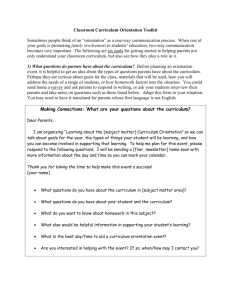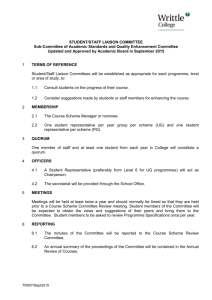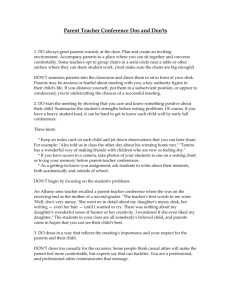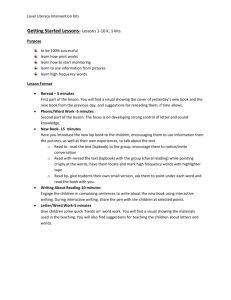About meeting individual needs
advertisement
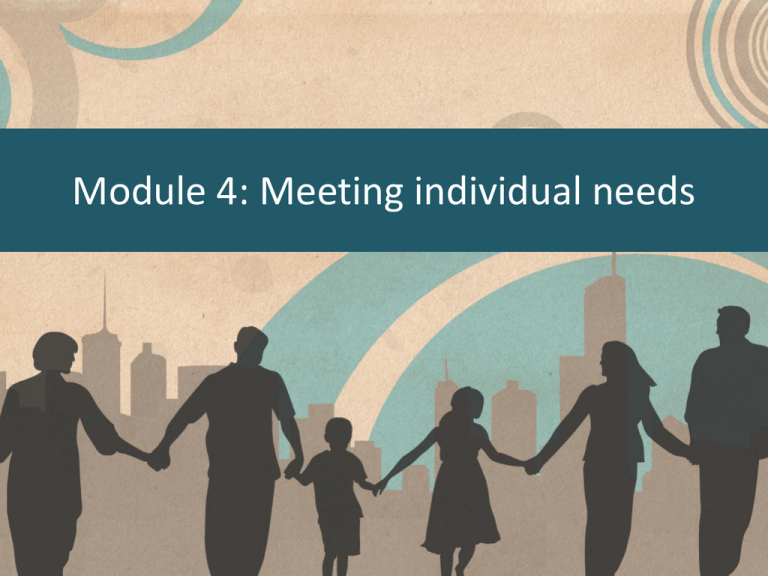
Module 4: Meeting individual needs Meeting individual needs What does this mean? Individuals requiring care will not all have the same needs. Look at these images and suggest ways in which each individual will need care. Module 4: Meeting individual needs Why is care planning important? Care planning addresses an individual’s full range of needs which can impact on health and well-being, for example medical needs. Can you think of five other needs? Use the images to help you then click on each one to see our suggestions. educational mental health economic Care needs ? ? personal ethnic and cultural background medical By taking into account an individual’s wider circumstances, care planning can be personalised to them. Module 4: Meeting individual needs The care planning cycle: what is involved Discuss what each stage involves then click on the boxes to find out more. Can be made by a health or social care professional, an individual or their carer. Referral Discussion of the care plan’s effectiveness and whether care should continue, be improved or reduced. Review/Evaluation Checks to ensure the individual is provided with the correct care, at the right time and place. Monitoring Assessment Identifies where the individual needs support. Production of a care plan stating who will do what and when, using which services. Care Planning Implementation The care plan is carried out. Module 4: Meeting individual needs The care planning cycle: how is it carried out? Discuss how each stage is carried out then click on the boxes to find out more. By phone call, email or letter to either social services or a GP. Each care plan will be reviewed within the first six weeks and at least once a year. Meetings are held between the MDT as well as with the individual and their family. Review/Evaluation Home visits, telephone calls, letters, questionnaires, Monitoring observations and recording of any complaints. Referral Assessment For social care, this is usually at home where the individual is interviewed and observed doing a set of practical tasks. For health care, this usually takes place in a hospital setting. Care Planning A multi-disciplinary team (MDT) meeting is held, with the individual and carer consulted. Implementation Those identified in the care plan will carry out their allotted tasks as described. Module 4: Meeting individual needs Care planning in action Now watch this video clip about Gladys, an elderly lady whose care plan enables her to remain at home. As you watch the clip, think about the benefits of the care plan for Gladys. Click here for a blank table to complete while you watch the video. Click here for a completed table with some sample ideas to compare with yours. Module 4: Meeting individual needs Who could be referred for an assessment? Individuals with a range of health or social needs can be referred. Use the pictures below to help you then click on each one to see our suggestions. People with learning disabilities People with sensory impairment People with mental health needs Who? People who misuse substances People with physical disabilities Older people with care needs Carers needing support Module 4: Meeting individual needs What does the assessment involve? Look at these images and discuss what the assessment might involve. The assessment is a detailed consideration of the individual’s capabilities to determine their care needs. Click here to see an example of an assessment checklist. Module 4: Meeting individual needs Who is involved in an assessment? A number of health and social care practitioners are involved in the care planning process alongside the individual and their carer. Record some examples here then click in the boxes below to see our suggestions. Health Care Social Care In GP practices: practice nurses In hospitals: specialist nurses In homes: community matrons, case managers and social care workers. Social worker or others including occupational therapist. Module 4: Meeting individual needs What care is provided in a care plan? Record some examples here and then click in the boxes below to see our suggestions. Health Care Social Care General health care needs: • Medication • Changing dressings/catheters • Blood pressure checks • Palliative care • Physiotherapy Help with daily living tasks: • Personal hygiene • Washing and ironing • Cooking • Cleaning • • • • Shopping Getting in/out of bed Transport Disability equipment and adaptations to the home Module 4: Meeting individual needs Interventions Choose six interventions below that could be included in the care plans on the right. Click to highlight the colour that matches the care plan. Named care workers visit Stair lift installed Given injections Escorted to GP Blood pressure checked Intercom system Dressings changed Medication administered Raised toilet seat Assistance dressing Walk-in shower fitted Adapted cutlery provided Prescriptions collected Guard rail on bed Aid call alarm Laundry washed Incontinence pads provided Bath hoist Dignity and hygiene (1 click) Safety and security (2 clicks) Health care (3 clicks) Module 4: Meeting individual needs Key features of a care plan Discuss the key features of a care plan with the following prompts in mind: What? Who? When? Then click to see our suggestions. • What care or equipment is needed. • Who is responsible for providing this care, service or equipment. • Who is responsible for making sure the care plan is carried out. • The names of key people involved and how to contact them. • When services are expected to begin. • A review date. Click here to see a sample blank care plan. Click here to see a sample completed care plan. Module 4: Meeting individual needs Benefits of care planning Three benefits are listed below. Can you think of five more? Record your ideas then click to reveal our suggestions. Benefit 2 Benefit 1 An accurate diagnosis. A choice of treatments decided by a group of experts, rather than by one doctor. Benefit 4 Benefit 3 Better coordination and continuity of care. Benefit 5 Benefit 7 Benefit 6 Benefit 8 • Reduced delays in care and waiting times. • All care needs considered. • Appropriate and consistent information offered. • Personalised care and services. • Independence is promoted. Module 4: Meeting individual needs Case studies Look at the following case studies and think about each individual’s care needs. Discuss how care plans would be devised for them. Stuart is a 5 year old boy who was diagnosed with cerebral palsy after an accident. He now has to use a wheelchair, his speech is slurred and he needs help with all daily living activities. He lives with his parents and two brothers. Investigate the local care provision available to support the care needs of the family. Sophia is 38 years old. She is married with two children. After discovering a lump in her breast she has been diagnosed with cancer. Investigate the local care provision available to support women in the prevention, diagnosis and treatment of breast cancer. Click here to see a table showing each individual’s needs identified. Module 4: Meeting individual needs

